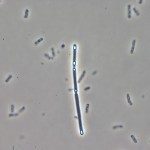Lien vers Pubmed [PMID] – 39189748
Lien DOI – 10.1128/mbio.01591-24
mBio 2024 Aug; (): e0159124
Clostridioides difficile, the major cause of antibiotic-associated diarrhea, is a strict anaerobic, sporulating Firmicutes. However, during its infectious cycle, this anaerobe is exposed to low oxygen (O2) tensions, with a longitudinal decreasing gradient along the gastrointestinal tract and a second lateral gradient with higher O2 tensions in the vicinity of the cells. A plethora of enzymes involved in oxidative stress detoxication has been identified in C. difficile, including four O2-reducing enzymes: two flavodiiron proteins (FdpA and FdpF) and two reverse rubrerythrins (revRbr1 and revRbr2). Here, we investigated the role of the four O2-reducing enzymes in the tolerance to increasing physiological O2 tensions and air. The four enzymes have different, yet overlapping, spectra of activity. revRbr2 is specific to low O2 tensions (<0.4%), FdpA to low and intermediate O2 tensions (0.4%-1%), revRbr1 has a wider spectrum of activity (0.1%-4%), and finally FdpF is more specific to tensions > 4% and air. These different O2 ranges of action partly arise from differences in regulation of expression of the genes encoding those enzymes. Indeed, we showed that revrbr2 is under the dual control of σA and σB. We also identified a regulator of the Spx family that plays a role in the induction of fdp and revrbr genes upon O2 exposure. Finally, fdpF is regulated by Rex, a regulator sensing the NADH/NAD+ ratio. Our results demonstrate that the multiplicity of O2-reducing enzymes of C. difficile is associated with different roles depending on the environmental conditions, stemming from a complex multi-leveled network of regulation.The gastrointestinal tract is a hypoxic environment, with the existence of two gradients of O2 along the gut, one longitudinal anteroposterior decreasing gradient and one proximodistal increasing from the lumen to the epithelial cells. O2 is a major source of stress for an obligate anaerobe such as the enteropathogen C. difficile. This bacterium possesses a plethora of enzymes capable of scavenging O2 and reducing it to H2O. In this work, we identified the role of the four O2-reducing enzymes in the tolerance to the physiological O2 tensions faced by C. difficile during its infectious cycle. These four enzymes have different spectra of action and protect the vegetative cells over a large range of O2 tensions. These differences are associated with a distinct regulation of each gene encoding those enzymes. The complex network of regulation is crucial for C. difficile to adapt to the various O2 tensions encountered during infection.







